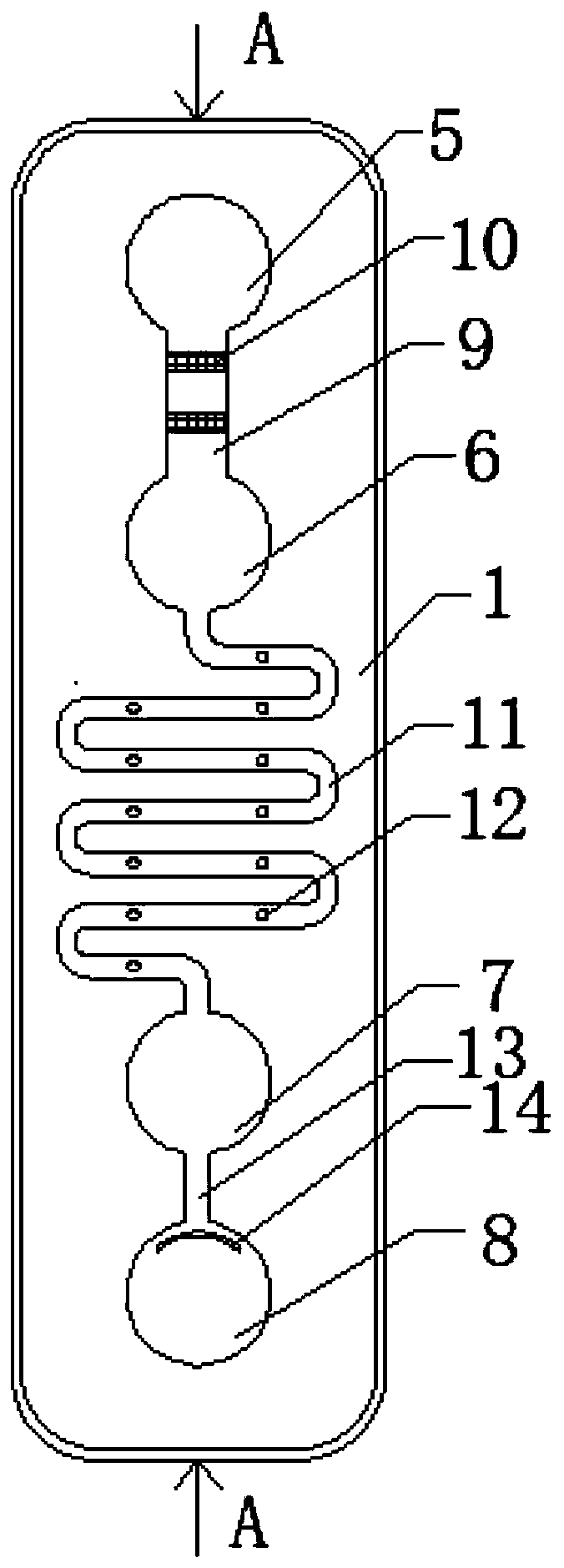Quantitative detection kit for Sflt-1
A quantitative detection and kit technology, applied in the field of kits, can solve the problem of low sensitivity and achieve the effect of high sensitivity, good repeatability, and small sample volume
- Summary
- Abstract
- Description
- Claims
- Application Information
AI Technical Summary
Problems solved by technology
Method used
Image
Examples
Embodiment 1
[0020] A quantitative detection kit for Sflt-1, comprising a substrate 1 and a cover plate 2, the substrate 1 and the cover plate 2 are formed by bonding, the cross sections of the substrate 1 and the cover plate 2 are rectangular structures, and the cover plate 1 is provided with a sampling hole 3 and a detection hole 4, and the substrate 1 is sequentially provided with a sampling area 5, a reaction area 6, a detection area 7, and a waste liquid area 8, and the reaction area 6 is coated with fluorescent microspheres Labeled sFLT-1 antibody I, sFLT-1 antibody II coated with different epitopes is immobilized in the detection area 7, the lower end of the sample application area 5 is provided with an opening connected to the upper end of the filter channel 9, and the reaction area 6 The upper end is provided with an opening to communicate with the lower end of the filter channel 9, the filter channel 9 is provided with multi-layer filter cotton 10, the lower end of the reaction zo...
Embodiment 2
[0028] In this example, the preparation method of the microfluidic chip for quantitative detection of sFLT-1 is described in detail, which specifically includes the following steps:
[0029] (1) fixing the multi-layer filter membrane in the reaction channel;
[0030] (2) Wash the fluorescent microspheres with 0.05mol / L MES buffer (pH=7.2). After washing, add carbodiimide and N-hydroxysuccinimide, and react at room temperature for 2 hours to obtain a fluorescent microsphere solution. The sFLT-1 antibody I was dissolved in 0.05mol / L PBS buffer (pH=7.2) to obtain the sFLT-1 antibody I solution, and the fluorescent microsphere solution was added to the sFLT-1 antibody I solution, reacted at room temperature for 2 hours, and centrifuged. Wash 3-5 times with 0.01mol / L PBS buffer (pH=7.2) to obtain sFLT-1 antibody I labeled with fluorescent microspheres, and apply the sFLT-1 antibody I labeled with fluorescent microspheres dropwise on the reaction area;
[0031] (3) Immobilize and c...
Embodiment 3
[0035]Performance analysis of this kit:
[0036] 1. Linearity: The kit uses the concentration value of the sFlt-1 standard substance (0, 10, 50, 400, 2000, and 10000 pg / mL for the standard substance) as the X-axis, and the signal value of the standard substance as the Y-axis to establish a calibration Curve, according to the intensity of the signal value of the sample to be tested back to calculate the corresponding concentration value, such as Figure 4 As shown, the linear equation is y=246.44x-9948.5, R 2 =0.996, the lowest detection limit is 10pg / mL.
[0037] Get the sFlt-1 standard substance that concentration is 10pg / ml and carry out 10 tests, utilize linear equation y=246.44x-9948.5, calculate detection concentration value; Detection result is as shown in table 1, and the average value of determination is respectively 9.994pg / ml , the standard deviation was 0.3997, and the intraassay coefficient of variation was 4%.
[0038] Table 1
[0039] sFlt-1 stan...
PUM
 Login to View More
Login to View More Abstract
Description
Claims
Application Information
 Login to View More
Login to View More - R&D
- Intellectual Property
- Life Sciences
- Materials
- Tech Scout
- Unparalleled Data Quality
- Higher Quality Content
- 60% Fewer Hallucinations
Browse by: Latest US Patents, China's latest patents, Technical Efficacy Thesaurus, Application Domain, Technology Topic, Popular Technical Reports.
© 2025 PatSnap. All rights reserved.Legal|Privacy policy|Modern Slavery Act Transparency Statement|Sitemap|About US| Contact US: help@patsnap.com



